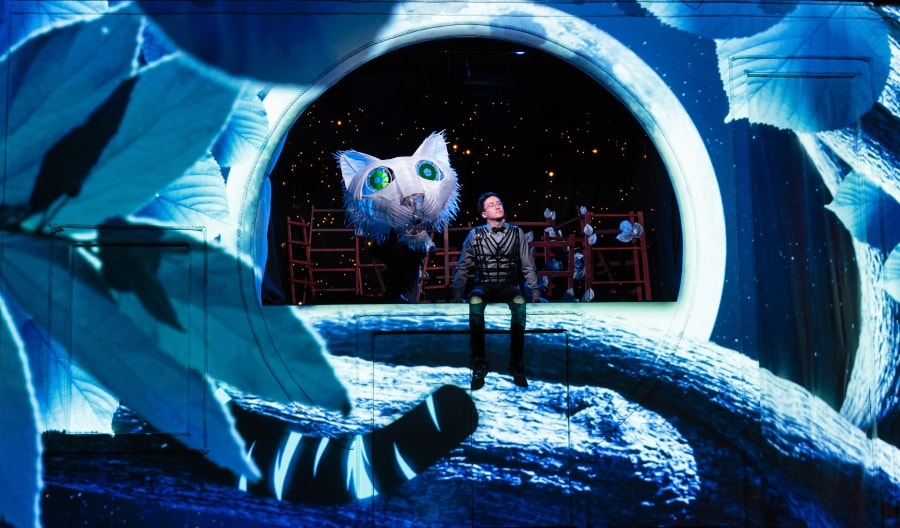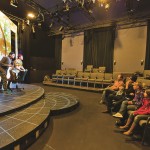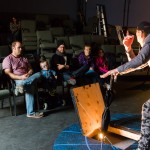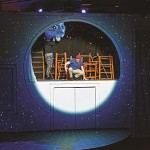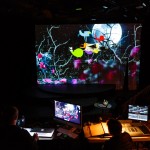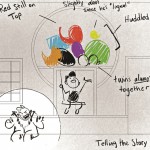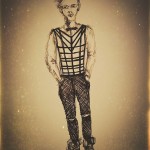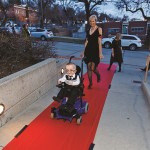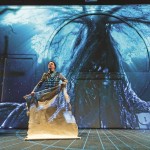“Get your feathers ready!” someone yelled in the chapel theatre just as the first run-through was about to begin. Only two days remained until the first preview, and the cast and crew of Salt Lake Acting Company’s Climbing With Tigers were getting ready to take flight. A screen showed multicolored birds perched on a tree branch, while two extravagantly costumed actors prepared to tell the story of Blue the blackbird and his adventures. The production, which ran March 4–27 at SLAC’s 113-seat venue, represented a departure for a company already known for bold departures: It was a partnership with two outside companies on a play adapted from a book cowritten by a young child.
The journey to the SLAC stage began years ago, when Salt Lake City–based artist Dallas Graham founded the Red Fred Project, an initiative that gives children with critical illnesses and rare diseases the opportunity to create a book. The first Red Fred author was Nathan Glad, a 7-year-old with osteogenesis imperfecta, also known as brittle bone disease; with Graham he wrote the book Climbing With Tigers, about a bird with brittle bones, which paired Glad’s words with Graham’s graphic design and photography (the Jolly Troop, a colorful group of birds, is formed entirely out of exclamation points and commas). Subsequent books followed a similar formula.
This effort caught the attention of Flying Bobcat Theatrical Laboratory, also based in Salt Lake City, which worked with Graham to conduct “playshops” with children from organizations such as the Ronald McDonald House, Angel’s Hands Foundation, and the Boys and Girls Club. Flying Bobcat founders Robert Scott Smith (who goes by Scott) and Alexandra Harbold (who goes by Andra) led children in making masks and exploring the books’ Jolly Troop birds. The theatrical potential seemed obvious to everyone involved, and soon Flying Bobcat commissioned playwright Troy Deutsch, a longtime friend and collaborator, to adapt Climbing With Tigers for the stage.
Deutsch worked to keep the key elements of Glad’s book, transforming the short volume into a 51-minute play. The story follows Blue, a little blackbird with brittle bones who is afraid to fly, but who travels with the Jolly Troop through the Rosewood Forest into the Dark Barn, where a dragon dwells, and finally to the lair of Thunder Tiger—who, according to legend, has a magical tail with healing powers. Deutsch’s adaptation expands Glad’s 54-page tale into an epic hero’s journey.
“I added a sense of time to the journey, starting in the daylight, letting the sunset and the moon come out, and then having the birds fly until the morning,” said Deutsch. He also created different personalities for each of the Jolly Troop birds. “I identified each of the locations mentioned in the book and built upon them so they felt like dynamic, living, breathing worlds for the characters to play in,” Deutsch added.
Climbing With Tigers may be SLAC’s first collaboration with another company, but these partners weren’t strangers: The theatre has been a creative home for Smith as an actor and for Harbold as a director for many years. When Smith told SLAC artistic director Cynthia Fleming about the Red Fred Project and proposed a production, she said yes immediately.
“When we met as a group to talk about it, it was like everything that this company [SLAC] has been doing in the last five years has finally culminated in this place where a beautiful, special, heartfelt project feels safe that we can produce this, and take care of it, and do it in the right way,” said Fleming. “So it was a complete honor, and I felt like SLAC has earned it.”
What SLAC brought to the table was more than four decades of producing mostly contemporary plays; Flying Bobcat was brand new to the administrative aspects of theatremaking, including budgeting and marketing. Said Smith, “They loved the story, and they wanted to support it, and they wanted to support the company and give us some wings.”
Initially the play was going to be a season add-on at SLAC as a show geared toward children, but Fleming decided that the play and its message spoke more broadly to all ages and made the production part of the standard season. “All of our subscribers will want to see this,” she said. “It is artistically stretching all of us, and it is visually going to blow them all away. Instead of calling it a ‘children’s play,’ it is a Salt Lake Acting Company production that is rated G.”
In addition to tackling the logistics of producing, both SLAC and Flying Bobcat worked together to puzzle out the show’s many technical challenges. The staging fused animated storyboards, projected on a white set, with two live actors: Austin Archer, who played Blue, and Smith, who portrayed the narrator, Dred Fred, as well as Thunder Tiger. In addition to the actors, the animation represented the nine other Jolly Troop birds. With recorded voices for the on-screen characters and original music, the show required a certain amount of preproduction as well as trial and error in rehearsal to nail down the precise timing.
“The way our rehearsals were structured was a little different,” said Harbold, who directed the production. “We started out with our tech, essentially, because of the projections and the animation—trying to build to that so that there is a real conversation between the animation and the live action onstage.”
Archer agreed that the whole process felt like a long tech week. “We’ve been layering in pieces of tech pretty much every single rehearsal: new animation, new music, a new piece of the set to play with,” he said. “We knew that this was going to be almost more akin to making a movie than it is to making a play.”
The first hurdle emerged when it was decided that, instead of placing animated birds over existing video, as originally intended, it would be easier for the animator, Jarom Neumann, to create the backgrounds himself. As Neumann explained, “In my opinion, we were a little too spread out, and there was a lack of control in being able to make all those fine adjustments that we needed.”
Neumann worked closely with composer Kevin Mathie to build scenes inspired by the storybook and create the world for the actors to play in onstage—a process very different from animating to a prerecorded soundtrack for a film.
“In the animation world, it’s the exact opposite: We animate to all the sounds and the voices,” said Neumann. “Finding that balance has been quite the adventure.”
Said Mathie, “The timing for theatre isn’t as dependable as it is for film. I had to read the script, look at the still pictures, and listen to the actors’ recorded dialogue to come up with some themes.” Mathie created musical hooks for the birds’ entrances, and composed playful jingles to accompany the adventure through the Rosewood Forest, suspenseful music for the Dark Barn scene, and a magical score for the scene with Thunder Tiger. “This is the first time any of us have done animation that is integrated with live action, so it is a learning process for all of us.”
Rodney Cuellar’s costume design mirrored the darker, wilder elements of the script, and the costume silhouettes were reminiscent of Alexander McQueen, said Harbold, with a caged corset as a literal representation of Blue’s isolation and fragile bones. A tiger mask, created by Mark Hofeling, transformed the Thunder Tiger from the book’s blue-and-black–striped character into a three-dimensional magical creature, puppeteered onstage by Smith.
Set designer Thomas George’s scenery resembled a pop-up storybook of sorts. The white set, crafted to display the projections, included hidden curtains and doorways that allowed the live performers to jump through the animated world and into a three-dimensional reality. In front of the wooden white wall were three circular tiers for the actors to play on.
The voices of the Jolly Troop—which included Ty Burrell of “Modern Family” and his wife, Holly—were essential in bringing the birds to life. For each track, sound designer Adam Day worked with Harbold to select the tracks that worked best for the play. “The biggest challenge was that everything was recorded separately, and we had to make it feel like all the birds were right there together,” said Day.
Syncing the sound cues with the projections was a challenge for Day, as some of the scenes included only recorded voices and in others, the voices were part of conversations with the actors.
“It is interesting to have scene partners who are set in their choices—they are unable to make new choices,” said Archer, who played Blue, about the animated birds. “It is completely reliant on Scott and I to make sure that they feel alive and that they feel three-dimensional.”
In a way, the production’s stage manager, Annie Brantley, had to be the live actors’ scene partner. “Any time you call a show you are feeling out the cues—you are feeling out how this needs to flow here, this needs to fit here,” Brantley said. “But to be responsible for seven of the nine characters is a lot of work and has taken a lot of finessing on all of our parts.” In all, the show has 324 cues—a sizable challenge for a short play.
But when challenges came their way, the creative team on Climbing With Tigers met them with a common spirit. For everyone involved, the production was “a sort of gift to Nathan,” as Harbold put it. The challenge was “how to make his story come alive so that he both recognizes it and is completely blown away by it.”
Indeed, Glad’s occasional visits to the theatre proved to be a driving force for the cast and creative team. “Every time Nathan is in the room, every time that he comes to visit rehearsal, and every time that I get to spend a little bit of time with him,” said Archer, “it helps reground me where I need to be in that joy, that sense of wonder and adventure.”
But they wanted to save the full experience for opening night, and were nervous about Glad’s reactions. The narrator, for instance, was added for the play, bookending the story of Blue’s adventure, and the white Tiger Mask lacked the blue and black stripes that Glad had described for the character. To connect the book to the play, animator Neumann incorporated photographs from the book and from Glad’s own life into the backgrounds: images of a tree and a rosebush from Glad’s own yard, plus a pinecone ornament he made, became Easter eggs intended for Glad to enjoy.
“I feel more pressure in this piece because I want so badly to please Nathan, and I want for him to feel that he was represented accurately,” said Archer.
With one day left until the show’s first preview audience, Fleming jumped onstage to lend her choreography skills (she was in the original Broadway run of A Chorus Line) to tighten the narrator’s dance in the show’s introduction. The animation and tech were now set, she said, and now was the time for the actors to finally get a chance to play within it and finesse their performance—an odd reversal of the usual acting-first/tech-last process. Outside, SLAC staff members spray-painted silver leaves for Thunder Tiger’s tree. Dallas Graham decorated the lobby with cardboard cutouts of the Jolly Troop birds and put copies of Glad’s book on display.
At the four preview performances before opening night, children from groups who had attended some of Flying Bobcat’s initial “playshops”—the Boys and Girls Club and the Ronald McDonald House, and also a nearby elementary school—were the show’s first audiences.
“What the previews do is help us prioritize what we need to do,” said lighting designer Jesse Portillo. “There is nothing like an audience of 7-year-olds to tell you if what you’re doing is working or not.”
A coughing fit among the third graders cued them to dial back a scene with a fog machine and increase the animated smoke in its place. Later, when the onstage characters are stargazing, the young audience started craning their necks to look for stars in the house, so Portillo got to work creating sparkling lights to include in that scene, and Mathie went back to the studio to create music to sound like twinkling stars.
“The kids in some ways are the last magic piece—it is not really magic until they’re there, they see it, and it is real to them,” said Archer. With 24 hours until opening, the cast and creative team worked double time to make sure the wonders onstage matched the wonder in the audience.
During the curtain call at the first preview, a little voice boomed out of the dark: “I believe I can fly!” The next day, in a performance for third graders, a little boy named Enrique sat in awe in his first theatre experience. After the show, I had the chance to ask the audience if they would come see another play. Their answer? A resounding “Yes!”
“It’s time to roll out the red carpet!” shouted Cynthia Fleming, surveying the sidewalk outside the theatre on opening night. Minutes later, an ecstatic Nathan Glad, now 9 years old and clad in a black tuxedo (and his left arm in a white sling), arrived at the event with his family. He graced the red carpet in his electric wheelchair racing to see the show. “I’m so excited!” he yelled to the people lining the entrance before taking his spot in the theatre.
The opening performance had one glitch—the sound and the animation became misaligned—that caused a short pause at the start. While the audience waited for the crew to fix the problem, Glad happily took the stage with Red Fred Project founder Graham to read the book aloud.
Over cookies and chocolate milk at the post-show party, Karen McCormick, who works with disabled children and was familiar with the book, said she read about the show in the local paper. “It was interesting to see the story come into a play—I didn’t know if they could pull it off,” said McCormick.
Added Mark Zimmer, a SLAC season subscriber of 15 years, “It was well done and it had a good message; I liked it very much.”
“I like the idea of the multimedia presentation; I think that is where theatre is going and I am happy to see SLAC getting on the cutting edge of theatre,” said Marty Moore, a lawyer who frequents SLAC productions.
Then the most important critic weighed in. “I thought it was great!” exclaimed Glad in a post-show interview. Blond and bespectacled, he was a bundle of barely contained energy. “My favorite part was when the narrator is making a statement about the jungle and a leopard pops out and he says, ‘Whoa, wait!’”
That’s more or less the response he expected his schoolmates to have when they attended the following week. “I think my class is going to be, like, ‘Whoa!’”
Local reviews echoed the praise of young audience members and subscribers. An uncredited review in City Weekly read, “Some works of art are bigger than themselves. You know them when you see them—or, more often, when you feel them.” Morag Shepherd of the Utah Theatre Bloggers said she cried at the show’s introduction, adding, “Nothing I can write here will truly capture the invisible magic that happens on and around the stage of this show.”
Fleming said she hopes that SLAC’s mentorship of Flying Bobcat Theatrical Laboratory leads to more stagings of Red Fred Project books. So far the organization has completed eight books, and aims to produce one in each U.S. state, each story featuring a child with a different critical illness or rare disease. “Perhaps Andra and Scott can go to different states and say, ‘We can help you put this up in your hometown,’” said Fleming. “It would be a gorgeous thing for every state to have a production of one of Dallas’s books.”
Said Red Fred Project’s Graham, “What we have just done is a really gorgeous fabric of collaborative, creative effort. It involves so many people who have very specific talents and skill sets who weren’t involved in the book process.” He, too, hopes that theatre companies across the country might adapt Red Fred Project books.
Two life lessons that conclude Climbing With Tigers, both the book and play, are “Sometimes our dragons help us,” and “When we are brave and go on adventures with our friends, we become stronger.” These lessons could be the takeaways from this collaboration as well.
“We had to learn and we are learning different creative languages,” said Fleming. “That can be challenging, but there has never been anything that is negative about it. Salt Lake Acting Company will be very different after this play because of what we have learned.”

